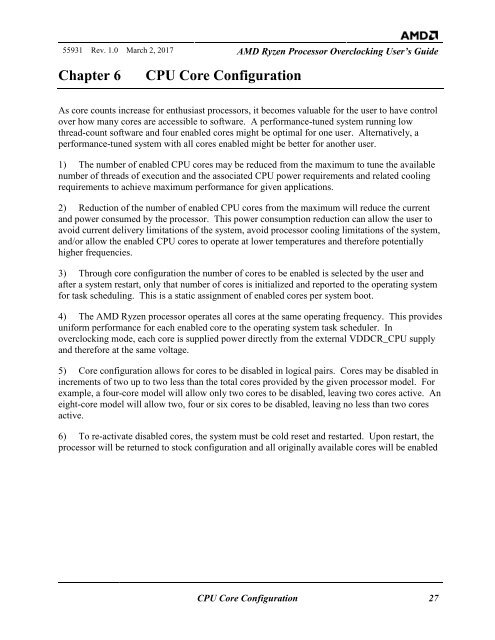AMD Ryzen Processor and AMD Ryzen Master Over-clocking User’s Guide
TwRGDa
TwRGDa
You also want an ePaper? Increase the reach of your titles
YUMPU automatically turns print PDFs into web optimized ePapers that Google loves.
55931 Rev. 1.0 March 2, 2017 <strong>AMD</strong> <strong>Ryzen</strong> <strong>Processor</strong> <strong>Over</strong><strong>clocking</strong> <strong>User’s</strong> <strong>Guide</strong><br />
Chapter 6<br />
CPU Core Configuration<br />
As core counts increase for enthusiast processors, it becomes valuable for the user to have control<br />
over how many cores are accessible to software. A performance-tuned system running low<br />
thread-count software <strong>and</strong> four enabled cores might be optimal for one user. Alternatively, a<br />
performance-tuned system with all cores enabled might be better for another user.<br />
1) The number of enabled CPU cores may be reduced from the maximum to tune the available<br />
number of threads of execution <strong>and</strong> the associated CPU power requirements <strong>and</strong> related cooling<br />
requirements to achieve maximum performance for given applications.<br />
2) Reduction of the number of enabled CPU cores from the maximum will reduce the current<br />
<strong>and</strong> power consumed by the processor. This power consumption reduction can allow the user to<br />
avoid current delivery limitations of the system, avoid processor cooling limitations of the system,<br />
<strong>and</strong>/or allow the enabled CPU cores to operate at lower temperatures <strong>and</strong> therefore potentially<br />
higher frequencies.<br />
3) Through core configuration the number of cores to be enabled is selected by the user <strong>and</strong><br />
after a system restart, only that number of cores is initialized <strong>and</strong> reported to the operating system<br />
for task scheduling. This is a static assignment of enabled cores per system boot.<br />
4) The <strong>AMD</strong> <strong>Ryzen</strong> processor operates all cores at the same operating frequency. This provides<br />
uniform performance for each enabled core to the operating system task scheduler. In<br />
over<strong>clocking</strong> mode, each core is supplied power directly from the external VDDCR_CPU supply<br />
<strong>and</strong> therefore at the same voltage.<br />
5) Core configuration allows for cores to be disabled in logical pairs. Cores may be disabled in<br />
increments of two up to two less than the total cores provided by the given processor model. For<br />
example, a four-core model will allow only two cores to be disabled, leaving two cores active. An<br />
eight-core model will allow two, four or six cores to be disabled, leaving no less than two cores<br />
active.<br />
6) To re-activate disabled cores, the system must be cold reset <strong>and</strong> restarted. Upon restart, the<br />
processor will be returned to stock configuration <strong>and</strong> all originally available cores will be enabled<br />
CPU Core Configuration 27


